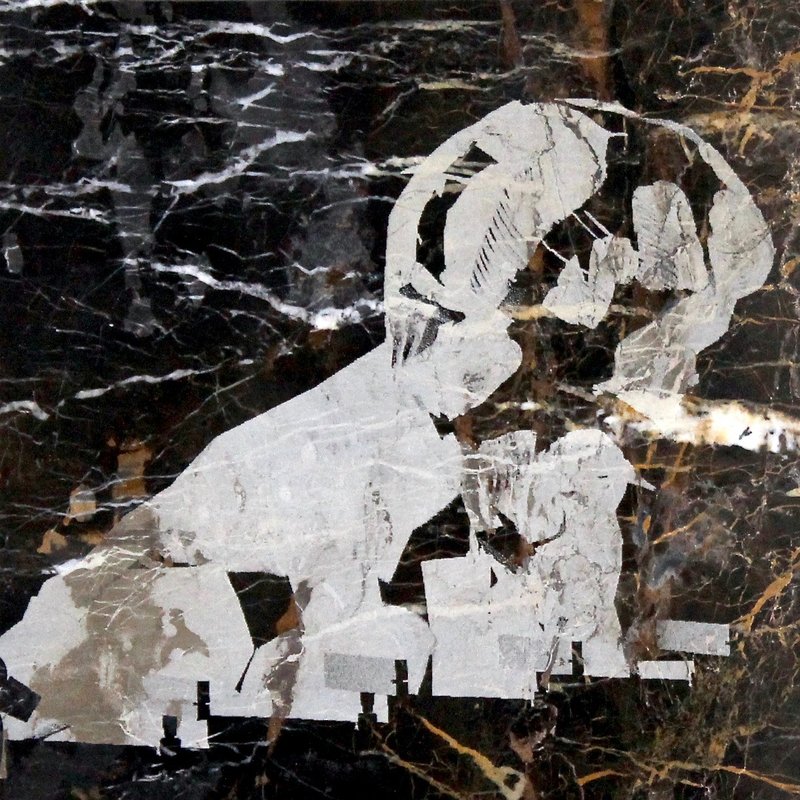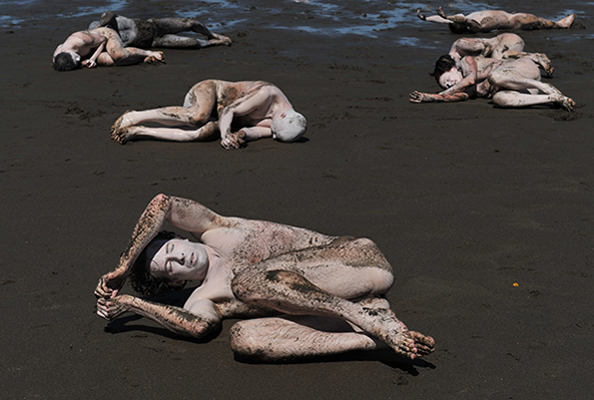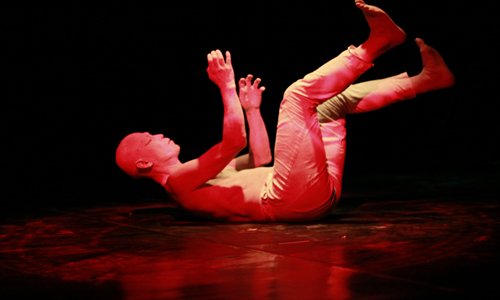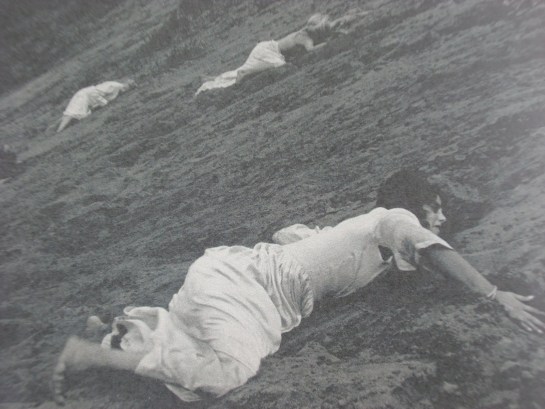Dark
produced by: Jana Velinova
Introduction
An interactive site-specific dance video installation built with Processing, Kinect and Isadora.
keywords: Site-specific, dance video, reflections, darkness, blackness
Background
As a dancer I’ve had the pleasure to work with interactive media artist Scott Snibbe. One of his works in particular, “Women Hold up Half the Sky”, I especially enjoyed working on and was one of my inspirations for this project. Snibbe’s piece is a permanent video installation that uses motion capture in a green screen space to create animations of the dancers as we portray women in science who have made significant contributions from ancient to modern times. Working this way was very enjoyable but also sparked my interest in whether there was a possibility to gather reliable motion capture data without the use of expensive equipment and a designated green screen space.
Then too, a few months ago, I had the chance to meet Marc Downie and Paul Kaiser of OpenEndedGroup at the Wayne McGregor Dance Studios in London who also really inspired me. They gave a talk on their artistic work over the years and specifically with choreographer Merce Cunningham and musician John Cage. From their talk, I was influenced to think about the potential of childlike play within a computational art work and the displacement of reality and meaning that is possible in the virtual through computation that is not so easily accessed in the physical world.
Concept
What would happen if we experiment with darkness? In absolute darkness, “you can not tell exactly where the limits of your body are, and also where the limits of the outside space are…so that in the darkness you fall into a kind of vertigo in which you enter into this becoming space which only darkness can actually provide you. And in that space the question is: Am I alive, or not? Do I exist…” (Bucharest, 2015 Lepecki)
So that being together with others in darkness allows us an experience of a new mode of existence away from being a person. An active and necessary depersonalization of the human happens in the dark, as Lepecki describes, and moves us towards de-materialization just as dance also does. What I was concerned with in making this project was the non- present, the remanence of memory as opposed to objects, the Derridean, the non-photo logical, all which give us the opportunity to live differently.
Being in darkness, we can begin falling into vertigo and we can dissolve ourselves, both viewer and performer and therefore have a chance to escape the photo logic imperative of the world. For Lepecki and other theorists, de-materialization is precisely the only possibility of a new materialization through the sharing of experience rather than of objects.
I was interested in exploring, how an art practice can be and what kind of aesthetic emerges when we move away from materials and objects which are ways of identifying ourselves in the world. What happens when we allow identity to slip way? Allow identifiers to slip away and instead try to inhabit the zones of obscurity, precisely the places for freedom from the 24/7 constant and continuous surveillance and control of contemporary society. Perhaps, in the dark we are free. We are not bound to our race, gender, age, body image in the dark everything becomes speculative rather than didactic, descriptive, or categorically signifying and signified.
The question then becomes: How can an aesthetic in the dark, in blackness, bring us away from the “fraudulent brightness that the state of 24/7 illuminant brightness brings us to” (Lepecki) and specifically also, how can I enact a darkness in my art practice when dance is something that must be seen to even exist.
Total darkness or the activation of shadows is therefore very important for this work. The piece is attempting to move away from the notion that performance requires the physical presence of both the performer and the audience. By giving nothing or very little to view it actually reveals something else. The meaning of the work is not the focus. Rather, a kind of imagining together for the viewer and the maker so that what is revealed is not based on prescribed communicable ideas by the artist. My aim is to move in a direction that is more expression rather than communication. I am actually not interested in communication, at all. Experience, expression, dissolving identity and signifiers, finding and bringing attention to the storyteller and the magic in the reality of the world through the use of computation were the aims, guiding this project.
The filming is at the entrance to the building with the camera shooting through the glass doorway enacting the relationship between the physical site and reflection. By bringing attention to the door at the entrance of the site, I hoped for a kind of re-enchantment of the world to be created for those visiting the space and viewing the recording later. A movement towards the magic that already exists in the space in reality, but becomes magnified and reflected so that we could actually see it through the use of computation and in the digital; becoming more and more visible through darkness.
My interest in darkness and the use of dark or black surfaces to reflect made the 1730’s abjected tool, the black mirror or Claude glass (a tool for artists and travelers that is black surfaced but nevertheless reflects) used to reflect and paint landscapes, very intriguing as well.
Technical
This project used Processing, Kinect, and Isadora. I used these because I started out wanting to use a green screen and motion capture space but decided that using a Kinect sensor would be more advantages since it is easy to transport and a lot more accessible in many ways. In processing, I went through a number of challenges which I had to overcome. I used point cloud within the Daniel Shiffman Kinect library for Processing developing many versions of the application. Particle systems falling, triangles creating a water-like creature out of the motion data, and many more. I eventually moved on to the Simple NI library which although I found challenging would allow for more efficient syphon into Isadora. I spent about a month learning the Isadora software and did eventually find it was more than worth the time because of it being specifically created for use in dance and movement performance. In the end, despite having explored numerous options, the codes I settled on using worked best to support the overall concept of my project.
Future development
I am extremely excited to continue working on incorporating computational art into my dance practice in general. The next step for me with this project specifically might be to develop a live feed version of the video. Adding the element of a live feed while visitors interact with the work would take it into a new and very interesting direction, and it is something I will explore in the future. I am also interested in a 360-video or live feed, allowing the streaming to incorporate the whole site. Finally connecting the streaming data from the camera to the motions of the participants so that their movements influences and changes the video image would be another development as well. I experimented with this largely in the Simple NI library using skeleton tracking with Isadora but felt the idea would need more time to develop properly to be folded into and incorporated well with the project.
Self evaluation
Overall, I am very happy with this project and feel I have started to find topics and research interests using computation and dance which are incredibly rich and potent. Unfortunately, during the exhibition, I was not fortunate enough to be allocated a dark space. Visitors, therefore, did not have the experience my work aimed to provide. I did set up a private viewing afterwords however where it was possible to see how the piece actually worked in the dark. Not really having been done justice during the exhibition, as the quality of light was of utter importance for the work I was still very pleased that many people stopped to talk with me about the work and those moments of exchange together are precisely what the work was aiming for, only, in the dark.
References
1. Jean, Jared St. ; Kinect Hacks: Tips & Tools for Motion and Pattern Detection
2. Lepecki, Andre; In the dark: a talk by André Lepecki in Bucharest 2015
3. A Practical Approach to Using Motion Capture in Performance Dance Conference Paper · June 2016 -Research Gate
4. Andres Colubri - Interactive video playback and capture in the Processing Language via GStreamer

Photo Gallery
1. Inspiration: Rachel Rossin; Claude Glass
2. Butoh dance of darkness, members of Kokoro Dance perform a butoh dance on the shore of Wreck Beach in Vancouver, July 10, 2010. Jenelle Schnider
3. Becoming, Wayne McGregor Studio, Computational Artist team creation
4. Sino-Japan Contemporary Dance Forum- Butoh performer
5. Anna Halprin
6. The Poetics of Space, Bachelard
7. Anna Halprin "Experiment in the Environment", 1962, Anna Halprin; the wife of Lawrence Halprin, Anna's experiments with the methods and experience of moving through space and it's capacity to generate environments were fundamental to the precise and profound interest in choreography and movement found later in Lawrence Halprin's landscape designs.





































































